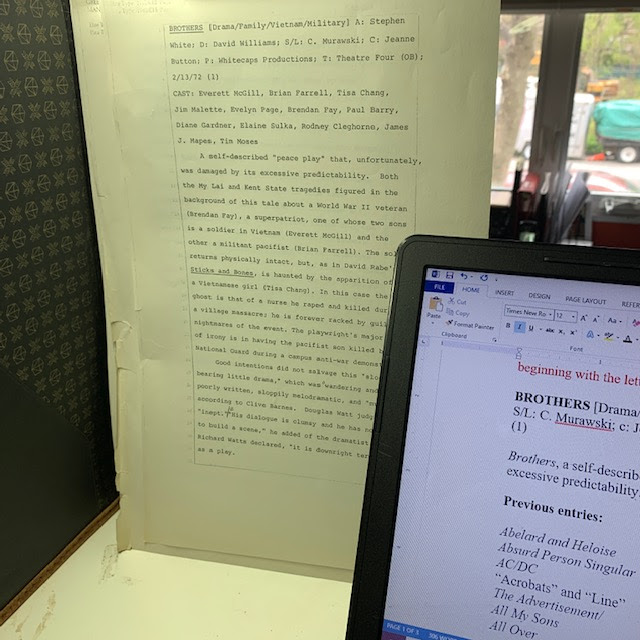 |
| The Bunraku troupe in Tsuri Onna (Fishing for Wives). |
"In Lieu of Reviews"
For background on how this previously
unpublished series—introducing all mainstream New York shows between 1970 and
1975—came to be and its relationship to my three The Encyclopedia of the New York Stage volumes (covering every New
York play, musical, revue, and revival between 1920 and 1950), please check the
prefaces to any of the earlier entries beginning with the letter “A.” See the
list at the end of the current entry.
BUNRAKU [Drama/Japanese/Puppets]
TR: Faubion Bowers; P: Kazuko Hillyer i/a/w City Center of Music and Drama,
Inc., in the National Puppet Theatre Production; T: City Center 55th
Street Theatre; 4/3/73-4/15/73 (17) Ehon
Taikōki (The Exploits of the Tycoon); Shinpan
Utazaemon (The Triangular Love); Heike
Nyōgo no Shima (The Priest in Exile); Tsuri
Onna (Fishing for Wives); Sonezaki
Shinjū (The Double Suicide at Sonezaki)
One
of the world’s theatrical gems, bunraku is a Japanese genre originating at the
turn of the 17th century in which slightly smaller than life-sized
puppets are manipulated in full view of the audience by three manipulators
each, one for the head and right arm, one for the left arm, and one for the
legs, all working in perfect coordination. Vocal passages are spoken and
chanted by one or more narrators seated on their knees behind a reading stand
on a platform at stage left, where they are accompanied by a similarly seated
musician playing the three-stringed shamisen.
Performances
are given in elaborate sets scaled to the size of the puppets but large enough
for a considerable number of them and their operators to appear. The plays are
principally of two kinds, historical and domestic, the latter depicting the
lives of everyday commoners during the Tokugawa period (1603-1868).
This
was the second visit of bunraku to America, following one in 1966, and included
a repertory of five plays representing examples of the historical and domestic
genres, with one dance piece (Tsuri Onna)
adapted from the comical form called kyōgen. Japanese theatre expert Faubion
Bowers translated the plays and provided simultaneous commentary on rented
headphones, as he did for many similar visits of Japanese troupes. The titles
of most of his translations are more descriptive of their themes than literal
versions of their Japanese meanings.
The
reviewers were suitably impressed by the skillful mastery of the performers,
and were surprised at how the onstage puppeteers soon seemed to fade from
notice as the highly articulated and realistically maneuvered dolls captured
all their attention. “Bunraku’s figures offer us the idea of the represented person rather than specific human beings,
even when the characters . . . are ostensibly a commonplace soy-shop clerk and
a courtesan,” wrote Harold Clurman.
The
effect of bunraku is best appreciated in the more intimate confines of the
smallish theatres they employ in Japan. This feeling was somewhat dissipated by
the cavernous City Center auditorium.
Previous entries:
Abelard and
Heloise
Absurd Person
Singular
AC/DC
“Acrobats”
and “Line”
The Advertisement/
All My Sons
All Over
All Over Town
All the Girls Came
Out to Play
Alpha Beta
L’Amante Anglais
Ambassador
American Gothics
Amphitryon
And Miss Reardon
Drinks a Little
And They Put
Handcuffs on the Flowers
And Whose Little
Boy Are You?
Anna K.
Anne of Green
Gables
Antigone
Antiques
Any Resemblance to Persons Living or Dead
Applause
Ari
As You Like It
Augusta
The Au Pair Man
Baba Goya [Nourish the Beast]
The Ballad of Johnny Pot
Barbary Shore
The Bar that Never Closes
The Basic Training of Pavlo Hummel
The Beauty Part
The Beggar’s Opera
Behold! Cometh the Vanderkellens
Be Kind to People Week
Berlin to Broadway with Kurt Weill
Bette Midler’s Clams on a Half-Shell Revue
Black Girl
Black Light Theatre of Prague
Black Picture Show
Black Sunlight
The Black Terror
Black Visions
Les Blancs
Blasts and Bravos: An Evening with H,L.
Mencken
Blood
Bluebeard
Blue Boys
Bob and Ray—The Two and Only
Boesman and Lena
The Boy Who Came to Leave
Bread
A Breeze from the Gulf
Brief Lives
Brother Gorski
Brothers
Bullshot Crummond



